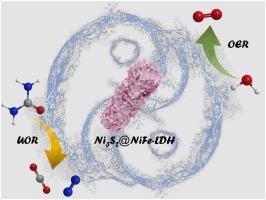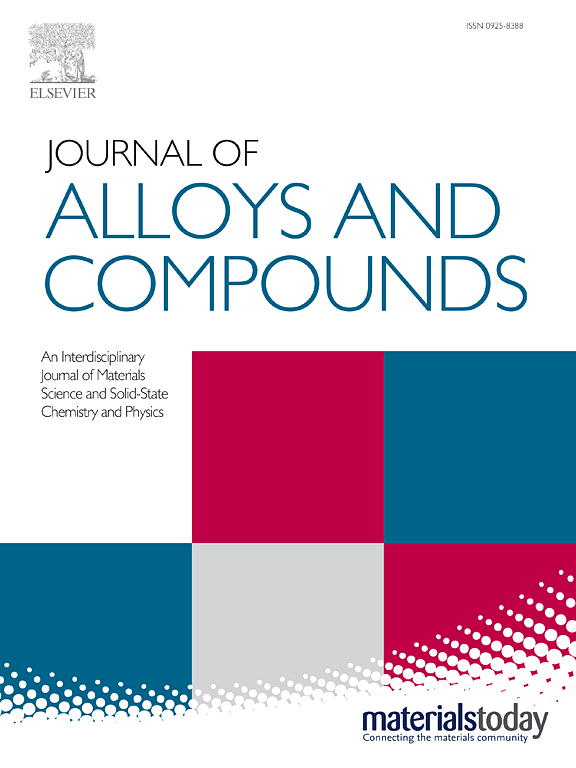Interface engineering of Ni3S2@NiFe-LDH core-shell heterostructure to achieve energy-saving hydrogen production
IF 5.8
2区 材料科学
Q2 CHEMISTRY, PHYSICAL
引用次数: 0
Abstract
Developing highly active and cost-effective catalysts for oxygen evolution reaction (OER) and urea oxidation reaction (UOR) is crucial to accelerate the scale-up of hydrogen production. However, their potentials in widespread use have been locked owing to the sluggish reaction kinetics. Herein, we present a unique three-dimensional heterostructure, in which the self-supported Ni3S2 nanorods are wrapped by ultrathin nickel-iron layered double hydroxide nanosheets on nickel foam (Ni3S2@NiFe-LDH/NF). Benefiting from the uniform core-shell architecture and the modulated electronic structure, Ni3S2@NiFe-LDH/NF demonstrates superior activities for both OER and UOR. The electrode manifests an ultralow overpotential of 300 mV is required for OER to attain 100 mA cm-2 and operates stably for 200 h at 100 mA cm-2. Impressively, the UOR and overall water-urea electrolysis solely require 1.38 V vs. RHE and 1.43 V to supply 100 mA cm−2, greatly reducing the overall energy consumption in 1.0 M KOH with a 0.33 M urea. The in-situ Raman characterization results show that Ni3S2@NiFe-LDH undergoes surface reconstruction into crystalline γ-Ni(Fe)OOH during OER, while it transforms into amorphous a-Ni(Fe)OOH during UOR. This work demonstrates an effective interfacial engineering strategy to develop Ni-based catalysts, enabling energy-saving H2 production by efficient OER and UOR.

Ni3S2@NiFe-LDH核壳异质结构界面工程实现节能制氢
开发高活性、高性价比的析氧反应(OER)和尿素氧化反应(UOR)催化剂是加快氢气生产规模的关键。然而,由于反应动力学迟缓,它们的广泛应用潜力一直被锁定。在此,我们提出了一种独特的三维异质结构,其中自支撑的Ni3S2纳米棒被超薄镍铁层状双氢氧化物纳米片包裹在泡沫镍(Ni3S2@NiFe-LDH/NF)上。得益于统一的核壳结构和调制的电子结构,Ni3S2@NiFe-LDH/NF在OER和UOR中都表现出优越的活性。该电极具有300 mV的超低过电位,可使OER达到100 mA cm-2,并在100 mA cm-2下稳定工作200小时。令人印象深刻的是,UOR和整体水-尿素电解只需要1.38 V,而RHE和1.43 V就可以提供100 mA cm - 2,大大降低了1.0 M KOH和0.33 M尿素的总能耗。原位拉曼表征结果表明,Ni3S2@NiFe-LDH在OER过程中表面重构为结晶型γ-Ni(Fe)OOH,而在UOR过程中表面重构为非晶型a-Ni(Fe)OOH。本研究展示了一种有效的界面工程策略来开发镍基催化剂,通过高效的OER和UOR实现节能制氢。
本文章由计算机程序翻译,如有差异,请以英文原文为准。
求助全文
约1分钟内获得全文
求助全文
来源期刊

Journal of Alloys and Compounds
工程技术-材料科学:综合
CiteScore
11.10
自引率
14.50%
发文量
5146
审稿时长
67 days
期刊介绍:
The Journal of Alloys and Compounds is intended to serve as an international medium for the publication of work on solid materials comprising compounds as well as alloys. Its great strength lies in the diversity of discipline which it encompasses, drawing together results from materials science, solid-state chemistry and physics.
 求助内容:
求助内容: 应助结果提醒方式:
应助结果提醒方式:


